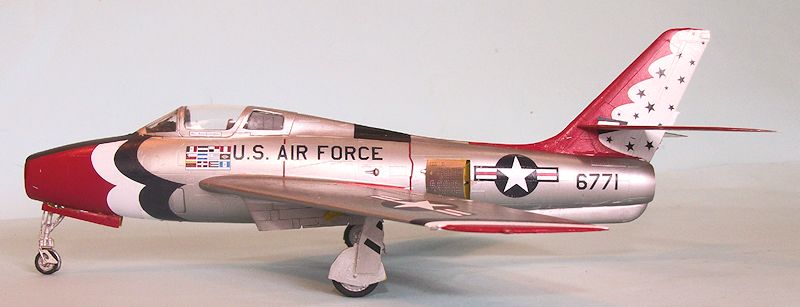
Hobby Boss 1/48 F-84F Thunderstreak
| KIT #: | 81726 |
| PRICE: | 5200 yen at HobbyLink Japan |
| DECALS: | Two options |
| REVIEWER: | Tom Cleaver |
| NOTES: |
Warbird Decals 48-010 “USAF Thunderbirds F-84F”, AMS Resins
cockpit and nosewheel well used. |

| HISTORY |
Following the
introduction of the North American F-86 Sabre with wings swept 35 degrees,
Republic determined to update their straight-wing F-84 with a swept wing.
A wing with 38.5 degrees of sweep and 5 degrees of
anhedral were developed and with similarly-swept tail surfaces were mated with
an F-84E fuselage with a J-35 engine.
First flown in 1950 as the XF-96, the airplane did not
show enough improvement over the straight wing aircraft to warrant production.
In 1951, the Air Force suggested re-designing the
airplane to utilize the J-65 engine, a license-build British Sapphire.
This involved extensive redesign of the fuselage, which
was deepened overall, with the speed brake moved from the lower fuselage to
separate brakes on the rear fuselage sides.
In the end, what was supposed to be an airplane with 55%
commonality with the straight wing F-84 ended up with less than 15% commonality,
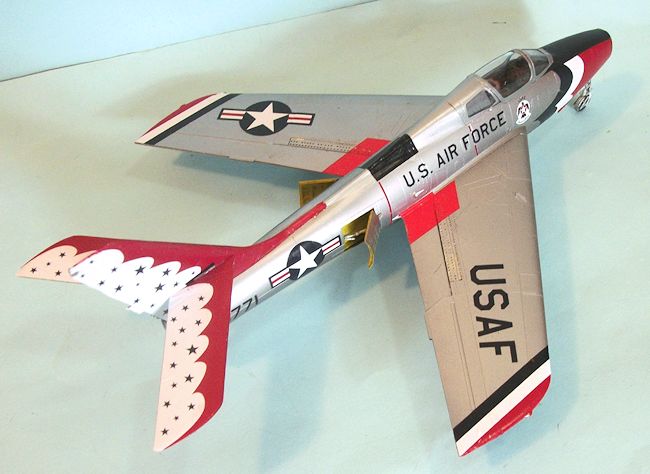 though its
designation was changed from F-96 to F-84F for procurement purposes since it was
easier to get funding for a development of an existing type from the Congress.
though its
designation was changed from F-96 to F-84F for procurement purposes since it was
easier to get funding for a development of an existing type from the Congress.
The first production
F-84F flew in 1952 and was judged far from ready for operational use.
Use of the conventional horizontal
stabilizers-with-elevator led to uncontrollable pitch-up in stall, with
potential separation of the wings from the fuselage.
The horizontal tail surfaces were replaced with a
single-piece flying tail with a wider span and chord.
The fact the airplane needed proess-forged wing spars
and ribs created difficulty since there were only three forges capable of
producing these in the country, and priority had been given over to the B-47
Stratojet.
Eventually, the
production-version of the F-84F appeared in 1954.
Originally designed as an escort fighter for Strategic
Air Command as had been the straight wing Thunderjet, the Thunderstreak as it
was known was transferred to Tactical Air Command, and on to the Air National
Guard by 1958.
The aircraft saw extensive operational use with NATO air forces,
replacing the F-84Gs in the French, Italian, Belgian and Dutch air forces, and
equipping the fighter bomber units of the new West German Luftwaffe, until
replaced in 1964-65 by the F-104G, at which point the surviving F-84Fs were
transferred to the Greek and Turkish air forces.
Air National Guard F-84Fs were activated for operations
in Europe in 1961 as a result of the Berlin Wall crisis.
The F-84F first came to public notice on March 9,
1955, when Lt. Col. Robert R. Scott set a 3-hour, 44‑minute and 53‑second record
for the 2,446 mile flight from Los Angeles to New York.
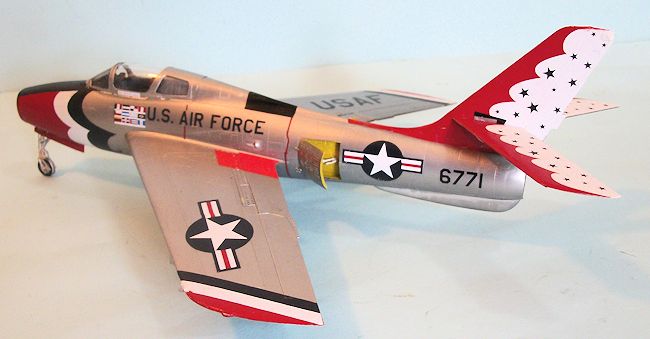 Combat use
of the F-84F was limited, with two French escadrilles participating in Operation
Musketeer in 1956, where they operated from Israeli airfields and flew long
range fighter bomber missions to hit the Egyptian airfields near Luxor on the
first day of the 1956 Anglo-French intervention in what was allegedly the “Sinai
War” but was really an Anglo-French-Israeli attempt to retake control of the
recently-nationalized Suez Canal.
In 1962, Turkish F-84s shot down two Iraqi Air Force
Il-28 Beagle bombers that strayed across the Turkish border while conducting
bombing missions against Kurdish rebels in northern Iraq.
Combat use
of the F-84F was limited, with two French escadrilles participating in Operation
Musketeer in 1956, where they operated from Israeli airfields and flew long
range fighter bomber missions to hit the Egyptian airfields near Luxor on the
first day of the 1956 Anglo-French intervention in what was allegedly the “Sinai
War” but was really an Anglo-French-Israeli attempt to retake control of the
recently-nationalized Suez Canal.
In 1962, Turkish F-84s shot down two Iraqi Air Force
Il-28 Beagle bombers that strayed across the Turkish border while conducting
bombing missions against Kurdish rebels in northern Iraq.
The F-84F and RF-84F
left ANG service in 1972.
They continued in Greek and Turkish service and were
used operationally in 1974 during the Cyprus crisis.
The last Greek RF-84Fs were retired in 1991, being the
last F-84s in service anywhere.
Founded in 1954 as the
official Air Force flight demonstration team, the USAF Thunderbirds were
originally equipped with F-84G Thunderjets, which were operated in 1954.
These were replaced by the F-84F for the 1955 season.
As a youth, I saw the team perform at Lowry AFB for the
opening of the then-new U.S. Air Force Academy, little knowing at the time that
I was watching the legendary Jack Broughton, who was at the time the leader of
the Thunderbirds.
| THE KIT |
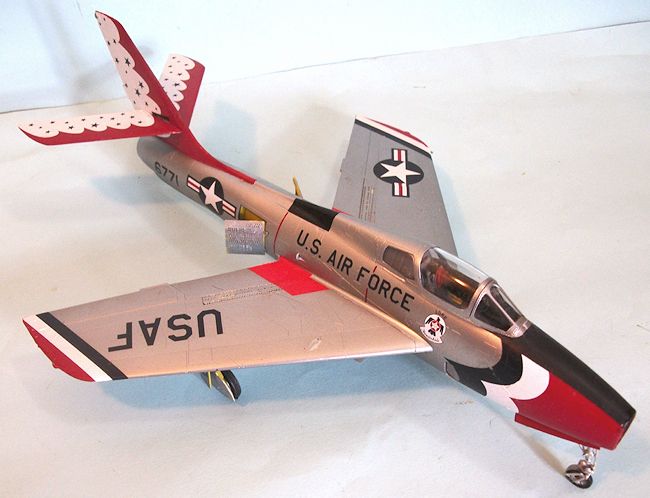
The decals provide the
same two airplanes that were provided in the original Monogram boxing.
The Kinetic decals will also fit, and they provide two
different aircraft including one ANG airplane.
One could likely also use the Heller decals, which
provide good French Air Force and Belgian Air Force options, with a very poor
USAF option.
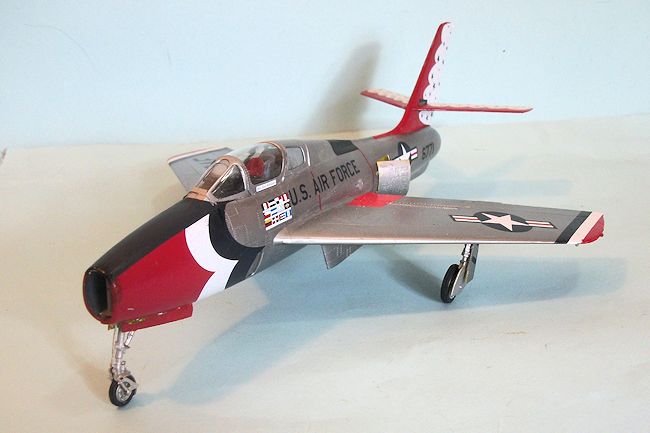 There are a
few aftermarket sheets for the F-84F, including one by SuperScale for a French
Air Force F-84F and one from the Italian Frecce Tricolri demonstration team, a
Belgian sheet of Belgian Air Force airplanes, another SuperScale sheet for a
Thunderbirds F-84F and a superior sheet from Warbirds Decals which is also for
the Thunderbirds and provides markings for all four aircraft flown that year.
Only the Warbirds Decals sheet is currently available,
though the others are available on eBay and from other specialty dealers (at
specialty prices).
There are a
few aftermarket sheets for the F-84F, including one by SuperScale for a French
Air Force F-84F and one from the Italian Frecce Tricolri demonstration team, a
Belgian sheet of Belgian Air Force airplanes, another SuperScale sheet for a
Thunderbirds F-84F and a superior sheet from Warbirds Decals which is also for
the Thunderbirds and provides markings for all four aircraft flown that year.
Only the Warbirds Decals sheet is currently available,
though the others are available on eBay and from other specialty dealers (at
specialty prices).
One very nice addition to the kit is an optional closed canopy. The clear plastic is very clear, and so one can close up the canopy and thereby preserve the lines of the airplane, while still being able to see the detail in the cockpit without trouble.
| CONSTRUCTION |
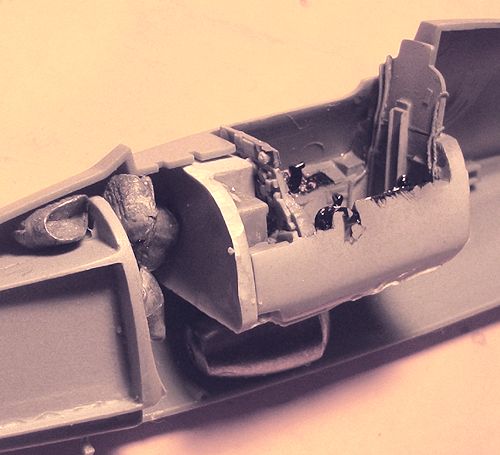 The
first thing I did was insure that the AMS Resins aftermarket parts I had for the
Kinetic kit I didn’t build would fit.
There is no problem doing this.
I had, however, used the seat in another project, so I
substituted the Kinetic seat in place of the overly-simplified Hobby Boss parts.
I painted and detailed the cockpit and installed it with
cyanoacrylate glue, and also installed the intake splitter/nosewheel well.
The
first thing I did was insure that the AMS Resins aftermarket parts I had for the
Kinetic kit I didn’t build would fit.
There is no problem doing this.
I had, however, used the seat in another project, so I
substituted the Kinetic seat in place of the overly-simplified Hobby Boss parts.
I painted and detailed the cockpit and installed it with
cyanoacrylate glue, and also installed the intake splitter/nosewheel well.
The rest of the assembly
was very straightforward, with no fit problems.
I did use Mr.
Surfacer on the centerline seams of the fuselage, then
rescribed the panel lines.
I left off the horizontal stabilizers, since I was going
to use the Warbirds Decals Thunderbird set.
The photoetch dive brakes are difficult to bend and get a full-curved surface, but with a little repeat effort they looked OK and were attached to the plastic interior parts.
| COLORS & MARKINGS |
The model was painted overall with Alclad Duraluminum,
then the wings were masked and the center sections were painted with Alclad
White Aluminum.
I decided to do the
airplane flown by Thunderbird Lead Major Jack Broughton.
The Thunderbirds decals from Warbirds Decals went on
without problems, other than the pieces for the tail assembly, due to the shape
and dimension differences between the Kinetic kit, for which the decals are
designed, and 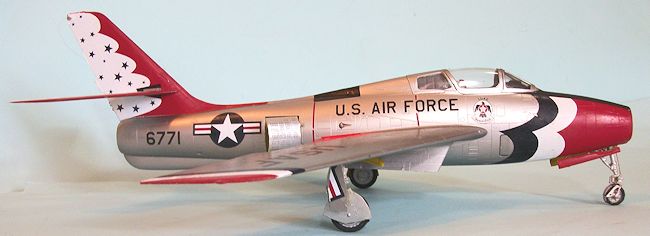 the
Hobby Boss kit.
I had to trim off the top of the decals for the vertical fin, and
then repaint the upper edge of the red color once the decals had set.
The one big problem was with the decals for the
horizontal stabilizers.
That is because the Hobby Boss kit has them in the
correct dimensions, which means they are each about 1/8 inch longer in span than
the Kinetic parts, and a bit wider in chord.
I was able to use the bits of red and white decal
provided on the sheet to cover this area, which is on the inboard end and pieced
together the proper look, I touched up along the leading edges with red paint.
the
Hobby Boss kit.
I had to trim off the top of the decals for the vertical fin, and
then repaint the upper edge of the red color once the decals had set.
The one big problem was with the decals for the
horizontal stabilizers.
That is because the Hobby Boss kit has them in the
correct dimensions, which means they are each about 1/8 inch longer in span than
the Kinetic parts, and a bit wider in chord.
I was able to use the bits of red and white decal
provided on the sheet to cover this area, which is on the inboard end and pieced
together the proper look, I touched up along the leading edges with red paint.
The sheet provides all
the markings needed, including the anti-glare panel on the nose and the area on
the spine behind the cockpit.
The decals went down without problem under Solvaset.
I unmasked the canopy, attached the horizontal stabilizers, and attached the landing gear and gear doors.
| CONCLUSIONS |
We now finally have an
F-84F that is accurate as regards exterior shape and dimensions.
Modelers who have the previous kits can turn them into
“aftermarket parts” to get the detail right, and the result will be a good
looking model.
With any luck, aftermarket decals for NATO airplanes and for
other USAF/ANG units will show up.
Recommended for those with an interest in 50s jets.
Review kit courtesy of HobbyLink Japan. Order yours at this link. Decals courtesy Warbirds Decals. Order yours at this link.
If you would like your product reviewed fairly and fairly quickly, please contact the editor or see other details in the Note to Contributors.